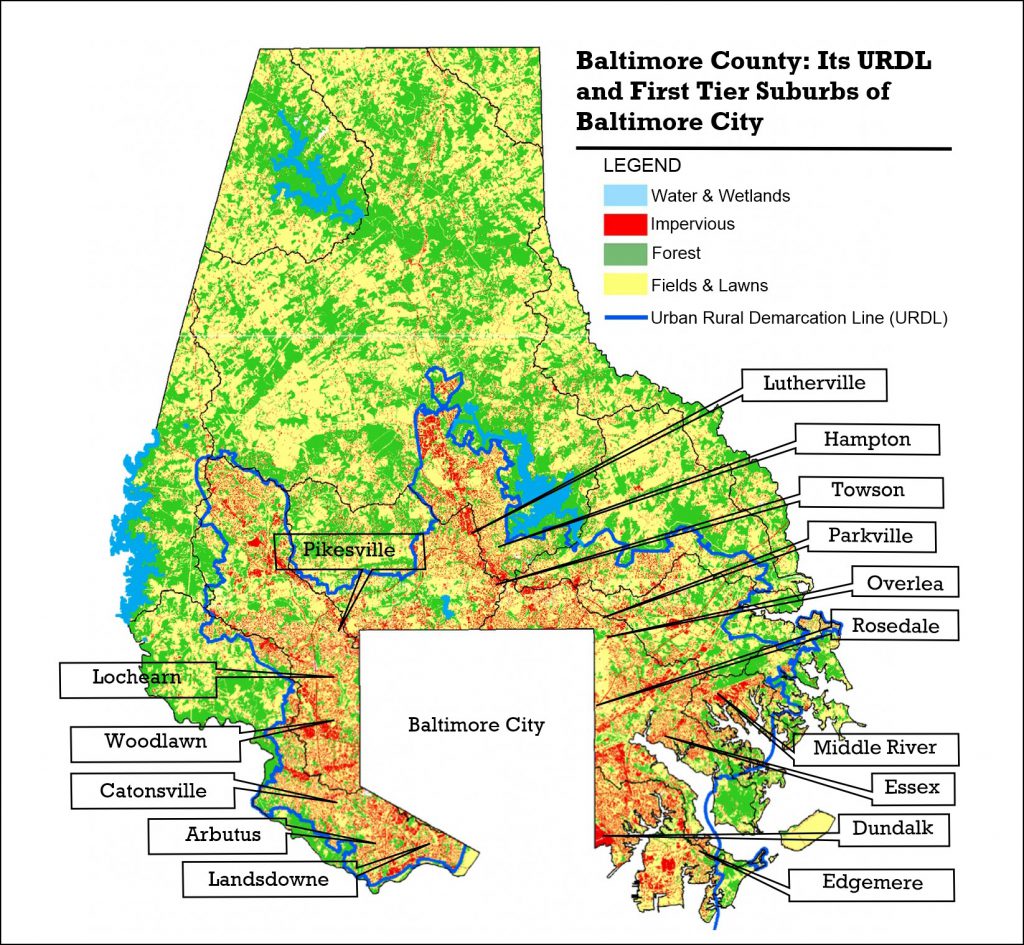I started out writing this article from the perspective of wanting to share with you a summary of items from the recently-released Baltimore County Government Transition Report (2019) that impact the NeighborSpace mission of improving livability in the inner suburbs. Maybe I would have stuck to that more limited scope had another document, the Report of the Spending Affordability Committee (Baltimore County, Fiscal Year 2020), not been released around the same time. Among other things, the latter describes an alleged failure of the previous Administration to govern responsibly when it comes to fiscal policy. The former is the new Administration's blueprint for moving the county forward, an effort that will be impacted in no small way by the errant fiscal policy of the past. The livability of our inner suburbs - our day-to-day quality of life - sits at a crossroads. It's been parked there much too long. We cannot afford for it to languish any longer. Rather, we, the citizens who call the inner suburbs home, must make some hard choices. Let me explain.
1. Baltimore County: "At a Crossroads" in 2008
The start of my tenure at NeighborSpace almost 10 years ago coincided with the publication of a book entitled, Transforming Race and Class in Suburbia: Decline in Metropolitan Baltimore. In it, author Thomas Vicino, a recognized expert on the political economy of suburban America, describes how the inner suburbs of Baltimore County, the places shown in the map below, experienced widespread

social and economic decline between 1970 and 2000, while outer suburbs flourished. Among the factors influencing decline were deindustrialization, racial diversity, class segregation, and government policy and planning. Among Vicino's memorable conclusions is the following, which I have quoted often:
Without a doubt, Baltimore County ... [has] reached a crossroads. The road to more decline may be an easy path to follow. It requires doing nothing and maintaining the status quo. The road to success depends on the political and social willingness to confront the decline of its suburbs. Ultimately, the fate of the first-tier suburbs rests with the people who call them home. (T. Vicino. Transforming Race and Class in Suburbia: Decline in Metropolitan Baltimore (Palgrave McMillan: New York, 2008)).
2. Baltimore County: "At a Crossroads," AGAIN, in 2019
-
"For FY 2020, ... the challenges of aligning expenditures with revenues are ... extraordinary - because for far too long, the County has been under-investing in our public schools and in our other needs."
-
"County budgets in recent years have not complied with the longstanding policy recommendations of the Spending Affordability Committee, resulting in more than $110 million in essential recurring expenses being deferred or funded outside the General Fund budget in FY 2019."
-
"In FY 2018 ... ongoing revenues were not sufficient to cover ... off-budget expenses [like retiree health care expenses] .... In the County Council's FY 2018 budget message, the Council drew attention to these concerns and restated prior requests by both the Council and the Spending Affordability Committee for a long-term financial plan, but the former Administration was non-responsive to all such requests. At or before reaching this critical juncture, other local governments would not have hesitated in considering revenue structure changes to address their needs. In fact, in FY 2019, all but one of the large Maryland counties had income tax rates exceeding 3%, while Baltimore County's rate has remained at 2.83% for more than a quarter century."
-
"Last year's FY 2019 Committee report again strongly reaffirmed the recommendation that the County act conservatively and adhere to all financial policies and recommendations; the FY 2019 Committee described itself as 'dismayed by unannounced policy decisions that have put at risk future retirement health care benefits for the County's current employees and retirees, as well as saddled the County with long-term commitments that are unaffordable under the current revenue structure.'"
-
"So, now, consistent with the Spending Affordability Committee's repeated fiscal warnings, the new County Executive and County Council are faced both with a structural deficit, which the Office of Budget and Finance estimates will exceed $80 million in FY 2020, and with a capital program that is understood to be unaffordable."
[W]e respectfully request that the County Executive provide with his FY 2020 budget submission a ... well thought-out proposal to tackle unbudgeted (and rising) retiree health care costs, ... a plan to reduce reliance upon bond premium funds to pay debt service interest costs, and a strategy to meet refuse disposal needs (especially in light of the City's action to tighten regulation of the Wheelabrator facility) without abandoning the County's commitment to its ten-year solid waste management plan. We hope that our partners in serving the public - including the State, the school system, bargaining units, developers, and businesses - will all recognize the real and serious challenges facing our County and show a willingness to share the burden of solving these problems with the local taxpayers who support them.
3.Getting Beyond the Crossroads
A. The Blueprint for FY 2020 and Beyond: The Transition Report
-
-
Education
-
Diversity, Inclusion, and Quality of Life
-
Government Reform and Innovation
-
Sustainability, Infrastructure, and Transportation
-
Public Safety
-
Health and Human Services
-
Job Creation and Economic Development
-
-
Diversity, Inclusion and Quality of Life, p. 19
-
Increase engagement with nonprofits and community associations;
-
Provide capacity building and board support for homeowner associations and community associations*
-
Establish a Grants Coordinator in the Executive's Office to seek resources in coordination with County departments and nonprofit partners, including community associations*
-
Forge a tangible and sustained partnership with the Baltimore Community Foundation (BCF) to address particular needs and opportunities, support neighborhood organizing and capacity of community associations, and improve quality of life
-
-
Government Reform and Innovation, p. 23
-
Create County-Stat, a County-wide performance management program*
-
Facilitate external engagement by creating platforms for innovation and engagement and training and best practice sharing for neighborhood organizations*
-
-
Sustainability, Infrastructure, and Transportation, pp. 28-31
-
Ensure that development is consistent with, and adheres to, community plans and the County Master Plan
-
Update and/or create community plans for all sectors of the County that reflect local community identity*
-
Establish a climate change adaptation strategy
-
Assess the state of smart growth policies and refine them as they relate to community revitalization and fiscal, environmental, and social sustainability
-
Engage the residential and business communities early in the planning process
-
Explore ways to strengthen the storm water management regulation beyond the state minimum to better handle the increase in flooding events
-
Develop public and private programs to reduce and replace unnecessary impervious surfaces with best management practices to reduce pollution from stormwater runoff*
-
Create a County-wide comprehensive green infrastructure plan*
-
Support organizations and efforts to preserve environmentally sensitive and active open space land within existing communities on the urban side of the URDL*
-
Update the Open Space and Landscape Manuals to require protection and maintenance of existing trees and forests, and to increase the urban tree canopy*
-
Meet MS4 permit requirements with a more stable, dedicated, and predictable fiscal mechanism
-
Establish permanent green infrastructure as the County builds and rebuilds gray infrastructure*
-
Compare the County's open space regulations to those of other jurisdictions and propose amendments to more effectively build an open space network inside the URDL that enhances walkability and access to green space in all communities
-
Collaborate with DEPS on forest planting, stream restoration, and other projects to improve environmental quality in community green space
-
-
Public Safety, p. 37
-
Identify youth who are at risk of becoming victims or perpetrators of violence by understanding risk factors; develop and implement programs/interventions for this population with the goal of reducing youth violence*
-
-
Health and Human Services, p. 42
-
Evaluate the efficacy and work of the Baltimore County Health Coalition through a lens of collaboration and coordination
-
-
Job Creation and Economic Development, pp. 48-51
-
Consider increasing barrier removal supports for residents who want to participate in training programs that include ... transportation3*
-
Implement a comprehensive multi-year workforce demonstration project for at-risk youth in Baltimore County Public Schools*
-
Expand the County's existing employer-driven workforce strategy*
-
Expand and support apprenticeship programs*
-
Expand the County's summer youth employment program and explore closer alignment with CTE programming at BCPS high schools*
-
Consider moving community development and housing programs and associated activities from the departments of Planning and Health and Human Services into a new and integrated agency: Community/Neighborhood Revitalization and Sustainability*
-
Establish an overarching strategy for neighborhood stability, with resources and incentives*
-
B. Building from the Blueprint
[t]his report cannot be read in a vacuum; it is being presented while the county confronts significant fiscal challenges. But I am confident that we will overcome these challenges by working together, being honest about where we are and where we want to go, and remaining steadfast as we build a better Baltimore County.
As a household would scale back its discretionary purchases when faced with a "maxed out" credit card, the County must now be prepared to make similar choices. As the saying goes, if we want things, we must pay for them, and if we are not able or willing to pay for them, then we can't have them or we will need to wait much longer to receive them. Unlike the federal government, which recklessly and irresponsibly continues to accrue debt due to annual operating budget deficits ..., we in Baltimore County are required by charter to balance our budget.
